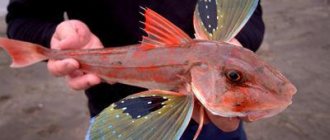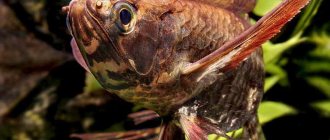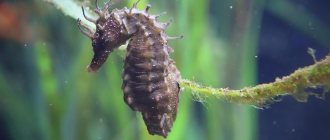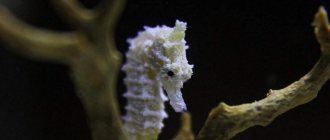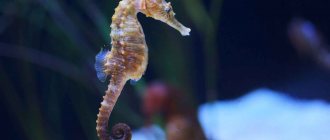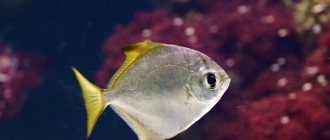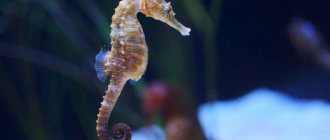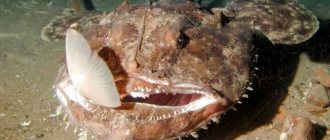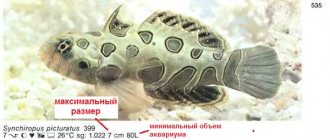Maintenance and care, arrangement of the aquarium
The size of the aquarium for successfully keeping these fish starts from 40 liters.
The design focuses on the upper part, everything else is adjusted to the needs of other fish, if any. There should be several floating plants on the surface of the water, arranged in groups and occupying no more than half of its area
At the bottom you can put several leaves, pre-dried and then soaked for several days (otherwise they will float). Fallen leaves will serve as a source of natural humic substances, which give the water tanning properties and color it a slightly brown color, characteristic of natural reservoirs in the habitats of the pygmy fish. During their games, hunting for insects flying low over the water or being frightened by something, the fish may accidentally jump out of the aquarium; use a lid or cover slips to avoid this. The basic set of equipment consists of a filtration and aeration system, a heater, and lighting fixtures, which are adjusted based on the needs of the fish, namely, low light brightness, no water movement. Recommended water parameters have acidic pH values and low carbonate hardness.
Sternicle or Amazon flying fish
The common wedgefish (lat. Gasteropelecus sternicla) or Gasteropelecus sternicla has a wedge-shaped body shape, although in English it is called “hatchetfish” - hatchet fish. Yes, this name for the wedge belly is even more correct, because from Latin Gasteropelecus is translated as “axe-shaped belly”
She needs this body shape in order to jump out of the water to catch insects that fly over the surface or sit on tree branches. The same behavior is observed in a similar-looking fish, the marbled Carnegiella. There are many fish that can jump out of the water in search of insects, but only these fish use their fins to adjust their body in flight.
The wedge belly is capable of jumping over a distance of more than a meter, and in flight controls its fins like wings.
Such jumping ability is impressive, but keeping a sternicle in an aquarium creates understandable difficulties. The aquarium must be tightly covered so that she does not end up on the floor at one point.
The fish are very peaceful, and even timid fish, they are well suited for keeping in community aquariums. They spend most of their time near the surface of the water, so it is better to have floating plants in the aquarium. But, do not forget that their mouth is located in such a way that they take food only from the surface of the water, and it should be in places with an open surface.
Habitat in nature
Sternicles were first described by Carl Linnaeus in 1758. The common cuneiform lives in South America, Brazil and the northern tributaries of the Amazon.
It prefers to stay in places with an abundance of floating plants, since it spends almost all its time at the surface of the water, and in case of danger it goes into the depths.
Very often they can be seen practically flying above the surface of the water, while hunting for insects.
Description
Tall, narrow body, with a large and rounded belly. Although in this case there is a big wrong word, it just looks like that from the side. If you look at the fish from the front, it is immediately clear why it was called wedge belly.
It grows up to 7 cm, and can live in an aquarium for about 3-4 years. They are more active, natural and live longer if kept in a flock of 8 or more.
The body color is silver with several black horizontal stripes. The upper position of the mouth, adapted for feeding from the surface of the water, is also characteristic.
Difficulty in content
The fish is quite difficult to keep, with specific requirements. Suitable for aquarists with sufficient experience.
Prone to semolina disease, especially when moving to another aquarium. It is advisable to quarantine only purchased fish.
Feeding
In nature, the wedge belly feeds on various insects and its mouth is adapted to feeding from the surface of the water. In the aquarium, she eats live, frozen and artificial food, the main thing is that it floats on the surface of the water.
It is also advisable to feed it live insects - fruit flies, flies, various larvae.
Keeping in an aquarium
It is best to keep them in a flock of 8 or more, in an aquarium with a capacity of 100 liters or more. They spend most of their lives near the surface of the water, so floating plants are a good idea.
Of course, the aquarium must be tightly covered, otherwise you will lose all the fish in a short time. Water for keeping should be soft (2 - 15 dGH) with ph: 6.0-7.5 and temperature 24-28C.
Since in nature the fish is quite active and spends a lot of energy while swimming and jumping, it is crowded in the aquarium and it begins to get fat.
To avoid this, you need to feed her in moderation, arranging fasting days once a week.
Compatibility
Well suited for community aquariums, peaceful. The fish are quite shy, so it is advisable to choose calm neighbors.
It is also important to keep them in a flock, with 6 being the minimum number, and 8 or more being the optimal number. The larger the flock, the more active they are and the longer their life expectancy
Good neighbors for them are a variety of tetras, dwarf cichlids, for example the Ramirezi apistogramma or the Bolivian butterfly, and various catfish, such as the panda catfish.
Breeding
Breeding the common wedge belly is quite difficult, and the fish are either caught from the wild or bred on farms in Southeast Asia.
External features of the family members
Arowana fish.
description, features, content and price of arowana fish Deep-sea hatchet fish or hatchet fish (Sternoptychidae) is a family belonging to the order Stomioformes, which includes 2 subfamilies consisting of 10 genera and 73 species. Distributed in the subtropical and tropical waters of three oceans: Indian, Pacific, Atlantic. They inhabit mainly the middle layers of deep-sea areas.
The body length ranges from 2 to 14 centimeters. The ax fish (photo presented in the article) is distinguished by a very high body, strongly flattened on the sides, as well as a caudal peduncle that sharply tapers towards the caudal fin.
Most varieties of this family have a bright silver color with a metallic bluish sheen and a darker, and sometimes almost black, back. Their eyes are large, and in species of the genus Argyropelecus, they are also telescopic, looking upward.
Transparent hatchetfish - Sternoptyx diaphana
Deep sea fish
Features
. The body shape is similar to an ordinary hatchet fish, but it is even taller: the height is only slightly less than the length of the body. The eyes are located laterally and look upward, and there is a transparent bony plate in front of the dorsal fin.
Coloring
. Dark olive green on the dorsal side, silvery on the sides of the body and ventral side; there are oval bluish-green luminescent organs on the belly, caudal peduncle and anal fin.
Dimensions
. Length up to 5 cm.
It is found mainly at great depths - 700-900 m; it is also noted at a depth of 3083 m and at shallow depths. During the day it remains at the same depth, i.e. it probably does not make daily vertical migrations. This species is quite common in the area of the edge of the continental shelf; it is extremely rare in coastal waters. Widely distributed in tropical and temperate latitudes of the Atlantic, Indian and Pacific oceans. The species has not been recorded in the Mediterranean Sea.
Although such features are interesting, the maintenance causes certain difficulties, so they are not recommended for beginner aquarists. There are several related species, differing primarily in size, these are the Silver Hatchetfish and the Great Hatchetfish.
Requirements and conditions:
- Aquarium volume - from 60 liters.
- Temperature - 22–28°C
- pH value – 6.0 – 7.0
- Water hardness - from soft to medium hardness (2-15dH)
- Substrate type - any
- Lighting - moderate
- Brackish water - no
- Water movement - moderate/weak
Fish parameters:
- Size - about 6 cm.
- Food - any, preferably meat products
- Life expectancy - from 2 to 5 years
Diseases
Aulonocara fish. description, features, contents and price of aulonokara
Hatchetfish are often infected with Ichthyobodosis. The main reason is unsatisfactory water quality; this disease is especially common in newly acquired fish. If the aquarium is mature and all parameters are normal, then health problems usually do not arise. Read more about symptoms and treatment methods in the section “Diseases of aquarium fish”.
Peculiarities
- Can jump out of the water
- Maintain a flock of at least 6 individuals
As the hero of one famous film said: “Space is simple, there is emptiness there.” Apparently, this is why our man-made vehicles have already approached the very borders of the solar system, but have not explored more than 5% of the world's oceans. Meanwhile, even this negligibly small part of knowledge is enough to be horrified by seeing those creatures that live in the depths.
Sackmouth is the only known genus of deep-sea fish of the family Sackmouth. They reach 2 meters in length and live at a depth of 2 to 5 kilometers. Their feature is a large, strong and flexible mouth with teeth curved inside the mouth. The skull of these fish lacks some bones, so the bagmouths easily open their mouths almost 180 degrees. At great depths there is not always enough food, so the fish has adapted to eat for future use, swallowing more food than its own weight and size. Having eaten your fill of sack, you can go without food for a long time.
Bird distribution
The habitat of the hatchet includes the coasts of the Asian and American continents. The birds nest from the North Pacific all the way to Southern California. In all these places, the hatchet is easy to recognize and see, since during the hunt the bird always flies over the water. Record-breaking populations of hatchet fish live in the Sea of Okhotsk. The total number of these birds here reaches from 3 to 4 million individuals. Colonies of hatchet whales of comparable numbers inhabit the Komandorsky, Kuril, and Yamsky islands. Puffin hatchets nest in large colonies, which are located on ocean coasts.
Weight parameters
Fish peled (curd) photo and description
The possibility of its use in wood processing depends on how heavy the tool is. The minimum value is considered to be a mass of 0.9 kg. Lighter models are used only for a limited range of household and household purposes when finishing small workpieces, for example, for sharpening wedges.
For standard work with wood, you will need a tool of 0.9-1.7 kg. It will be effective both when cutting medium-thick firewood and when carrying out construction work. Heavier splitting axes weighing 2.2-2.5 kg are used for chopping large firewood. They have a longer ax handle.
Breeding/reproduction
Breeding Marbled Hatchetfish requires some effort and a separate tank. A spawning aquarium of at least 40 liters, so that a couple of fish can feel comfortable. The composition of the water at the first stage should completely replicate the composition from the general aquarium. The equipment consists of a canister filter (high performance is no longer required), a heater, an aerator, and a low-power lighting system. In the design, floating plants are used, as well as rooted ones with wide or medium leaves. The soil is sandy, any decorative elements, although you can do without them with the same success. Several females and males are moved to a separate tank. Gradually the water is brought to values of 5.5–6.5 dGH. You can add a few dry leaves and a rag bag of peat to the aquarium; it is advisable to purchase it ready-made in pet stores rather than process it yourself. The water will become dark, but without suspended matter, which the equipment will filter. Lighting should be at half the power used in the main aquarium. Feed flying insects (fruit flies, mosquitoes or their larvae, bloodworms). After some time, these environmental conditions should encourage spawning. The female lays eggs in clusters on plant leaves or exposed roots, and the male fertilizes them. After this, the parents are returned to the common aquarium to prevent them from eating their own eggs. The fry appear every other day and begin to swim freely on the fifth day. Feed with microfeed, finely ground flakes, granules, and Artemia nauplii.
Natural enemies of isopods
Photo: Marine isopod
Isopods serve as food for many predators and omnivores. Aquatic isopods are eaten by fish and crustaceans, and are also sometimes attacked by octopuses.
Giant isopods are attacked by:
- large sharks;
- squid;
- other isopods;
- various deep sea fish.
Hunting a giant isopod is dangerous, since this creature is capable of seriously fighting back. Giant isopods fight to the end and never retreat - if they win, they eat the attacker. Isopods are not the most nutritious creatures, although many species (including woodlice) play an important role in the food chain.
Terrestrial isopods can be eaten by:
- birds;
- other insects;
- small rodents;
- crustaceans.
Woodlice have no defense mechanisms other than curling up into a ball, but this rarely helps them in the fight against attackers. Despite the fact that woodlice are eaten by many predators, they maintain a large population because they are very fertile.
In case of danger, isopods curl up into a ball, exposing their durable chitinous shell. This does not stop the ants who love to feast on woodlice: they simply roll the woodlice to the anthill, where a group of ants can safely handle it. Some fish are able to completely swallow an isopod if they cannot bite through it.
Catching perch with a hatchet at different times of the year
The hatchet spoon is often used only during winter ice fishing. During this period, fishermen act based on the type of reservoir on which they are located. If we are talking about a river, then there is no need to move far from the shore (and in some cases it can even be dangerous).
The humpback fish stays all year round, with rare exceptions, along the coastline overgrown with tall grass, its favorite depth is from 1.5 to 3 meters and you need to look for it by moving 5-8 meters from the shore. If fishing doesn’t work, then it’s worth changing your parking spot. Sooner or later, if you use a hatchet spinner, even this giant, wise with life experience, will not resist and will attack, becoming your treasured trophy.
On a lake, especially if it is large in size, you should not walk away from the shore either. Yes, large individuals sometimes gather there in groups and, even in winter, prefer to wander throughout the entire water area in search of prey. But using a heavy SUV to get to remote parts of the lake is more expensive. Therefore, you can be content with medium-sized perches, which are found in abundance not far from the shore.
In the summer, from June to August, perches are not very active. The highest chances of catching a large specimen will be on peat lakes. To do this, you will need to take with you a one and a half meter spinning rod equipped with an inertial reel system, a hatchet spinner, an inflatable boat and a friend who, in case of trouble, will help you get out of an unpleasant situation (the boat may capsize, and so on).
In peat lakes you can often find the real kings of the world, perches weighing up to 3 kilograms. The largest of all, however, are found only in open large bodies of water, such as the Baltic Sea, Baikal, Dnieper, Volga, etc.
The best times for catching perch are traditionally considered to be autumn and spring. In the fall, minke whales try with all their might to gain as much fat mass as possible in order to brighten up their existence during the approaching cold weather, which they really do not like. During this period, the perch eats everything that it can catch up with and that is smaller in size. Sometimes, you can get a small sailor out of the water, from whose mouth sticks out the tail of some kind of bleak, not much smaller than itself in size.
In the second half of May, perches are also found even more often than usual, which is not surprising. It is at this time that most freshwater fish begin their spawning period - a feast for the ubiquitous redfin, ever-hungry perch.
Sometimes, you can observe a picture of the so-called perch cauldron, when a flock of minke whales drives fry into shallow water, forming a seething circle, which attracts the close attention of seagulls. For a fisherman this is real luck; he can catch up to several buckets of small perches at this moment
However, humpback whales do not do such things. You can outsmart them only with the help of baits such as hatchet spoons.
This tackle can be used at any time of the year, but it is advisable to go fishing in good weather and not strong wind - humpback whales do not like this. From the shore, using a telescopic fishing rod up to five meters long, you can use this lure and with a high degree of probability you will get a couple of, if not trophy, then certainly large perches weighing from 500 grams. The hatchet also performs well when used as a spinner bait
Sometimes, even the usually cautious humpback whale will be led by an interesting thing and become the victim of a happy fisherman
But still, the best time to use this gear is winter, both early and dead. During the first ice, which generally begins in mid-late November, perches begin to move closer to the center of the reservoir, in pursuit of their food fish, but humpbacks remain true to traditions and can only be driven away from their usual rocky places by very low air temperatures.
For this reason, finding the intended habitat of a trophy perch will not be difficult, and the use of an improved hatchet-type spinner will not leave the slightest chance for the striped robber to escape.
The hatchet spoon for perch and other river predators is a seemingly primitive mechanism that can still provide the angler with a decent catch.
Thus, by making this miracle tackle according to the instructions given in this article, you guarantee yourself a successful catch that you will remember for the rest of your life!
Hatchetfish turned out to be the inventors of stealth technology
Argyropelecus aculeatus SEFSC Pascagoula Laboratory;
Collection of Brandi Noble, NOAA/NMFS/SEFSC Ichthyologists have discovered how hatchet fish manage to hide from predators. Their scales are capable of scattering light using a special two-layer structure, making them difficult to see both at the surface of the water and at greater depths. In addition, this structure allows some of the light to be directed downwards and emitted through photophores, making the fish invisible from this side as well. As a result, even direct light from the luminescent organs of predators does not allow them to detect these fish. The study was published in the Journal of the Royal Society Interface
Hatchetfish live in deep oceanic waters. Representatives of the genus Argyropelecus
, which were the subject of this study, have a silver color and large telescopic eyes directed upward. At night they rise close to the surface of the water, to a depth of about 50-100 meters, eating small crustaceans and other fish there, and during the day they descend back, to a depth of about 3600 meters. On their belly there are photophores, bioluminescent organs that have a camouflage function - when they glow, the fish from below become less noticeable against the background of a light sky. Similar organs are found, for example, in the firefly squid and midshipman fish, known for their buzzing.
The skin of hatchet fish superficially resembles the unpolished side of aluminum foil, but upon closer inspection it is a complex composite lattice of scales, which are sub-wavelength dielectric structures. The surface layer contains dielectric flakes, rectangular in cross section, and the deeper layer is elliptical. The cells of these scales are extended along the dorsal-ventral axis of the fish.
Dark-field micrograph in reflected light of hatchetfish scales and its spatial diagram of structure
Eric Rosenthal et al / Journal of the Royal Society Interface, 2017
Share
Scientists conducted a series of experiments, illuminating fish scales with laser beams, as well as, for comparison, highly reflective surfaces such as aluminum and spectralone. It turned out that when light falls on the side of the fish, a significant part of it is scattered, going into an arc parallel to the anterior-posterior axis of the fish, regardless of the initial angle of incidence. As a result, if you look at a fish in the water, it is as if you simultaneously see the water both in front of the fish and behind it, but the fish itself disappears. In addition, part of the incident light is scattered downward through the complex birefringent structure of the skin and emitted from the ventral photophores. This system provides reliable camouflage both under solar radiation and when illuminated by alien bioluminescent organs, which are very common among deep-sea predators.
Hatchet fish in diffused light. The ventral photophores are visible from below.
Eric Rosenthal et al / Journal of the Royal Society Interface, 2017
Share
Scales are one of the most important adaptations of fish to life in water. We recently talked about how artificially bred mirror carps, practically devoid of scales, recovered quite quickly after they were released into the wild. In conditions where there is nowhere to hide, and camouflage sometimes makes all the difference, the presence of an unusual and complex reflector system allows small hatchet fish to effectively survive at depths with different light conditions.
Anna Kaznadzei
Origin
Carnegiella marta is native to South America. It is found in the Orinoco River basin in Venezuela and the Rio Negro River, Amazon basin. Some specimens have been found in the Madeira River, and may also be found in other areas.
The wedge belly is a typical inhabitant of “black water”, living in reservoirs with sunken wood, a bottom covered with tree leaves and dense overhanging coastal vegetation. The water there is usually brown in color due to the presence of humic substances, and is acidic with low carbonate hardness. During the annual rainy season, water levels rise significantly, and small fish such as wedge bellies move into flooded forests, where they feed and reproduce until the waters return to their normal course.
In nature it occurs in small schools.
Lifestyle
Little is known reliably about the life cycle of the hatchet fish, because these representatives live in hard-to-reach places. According to many researchers, their life expectancy is no more than one year. At night, the fish are in shallow water (at a depth of approximately 200-300 meters), hunting for small fish and plankton. Usually she catches prey that swims above her. During the daytime, they return to depths of up to 2000 meters.
Some species can gather in large, dense schools, causing serious problems for vessels using echo sounders to determine depth. Sailors first encountered such a “double bottom” in the middle of the 20th century.
Such a massive accumulation of hatchet fish attracts some species of large fish of ocean waters to these places. Among them there are also commercially valuable species, for example, tuna. In addition, hatchets make up a significant part of the diet of some other, larger inhabitants of the oceans, for example, deep-sea anglerfish.
This type of fish reproduces either by laying larvae that mix with plankton and, as they mature, descend to depth, or by throwing eggs.
How to make a hatchet with your own hands
In order to make this spinner yourself, you will need:
- a tin of coffee or canned food;
- metal scissors;
- marker and ruler;
- sandpaper;
- awl;
- copper mounts that can be borrowed from other spinners or key chains, like
- option;
- vice;
- soldering iron;
- place for work;
- some free time.
A do-it-yourself hatchet spinner for perch is made as follows:
So, first of all, take a tin can and mark the semicircular shape of the future spinner on it with a marker. We give it the dimensions shown in the image below (Fig. 1):
Next, we need to use special scissors designed for metal carving to separate one fragment from the can. This element must be carefully processed with durable sandpaper until it is shiny. The edges of the product can be slightly bent so that when sharpening they do not turn into blades, but remain soft and safe.
The next step is to make holes at the top and bottom of the future spinner. To do this, you will need to heat the metal product over the flame, and with one sure movement, using a simple awl, make two holes. They should have clutches inserted into them, which can be borrowed from other failed spinners or from key fobs.
Using tin, merge three short hooks pointing in different directions. Attach the resulting product to the main body of the spoon. Also, it makes sense to use a single hook with a long shank, which is attached directly to the base of the spoon itself and fixed with superglue that does not get wet in water. From above you can fix this entire structure with special electrical tape.
The hole for coupling with the fishing line can also be made not directly at the end of the spoon, but on the right side relative to the direction of the hook, so that during the stroke the hatchet goes tilted to the side and takes streams of water with it, thereby better attracting the attention of some hungry predatory fish. In this case, the spoon may consist of two separate but identical bodies, fastened together using water-resistant electrical tape or other means at your discretion (Fig.
2).
There are several conventional varieties of this tackle: “poker”, “sail” and the “hatchet” itself, which in shape really resembles its counterpart among household tools. The heaviest specimens are created in order to use them in fast river currents, while in standing water, much smaller specimens are used.
Favorite colors for this gear are golden, silver and copper. But in order to catch an avid humpback whale, you will have to paint your “axe” in more natural, neutral shades, like greenish-brown, in order to give the whole structure a more or less natural look.
Description
A photo of an ax fish clearly demonstrates the uniqueness of its shape. It has another name - wedge belly. The body of the fish, covered with silvery, easily rebounding scales, is strongly compressed from the sides. Some varieties have an extension of the body in the area of the anal fin. The front part of the dorsal fin has the shape of a blade made of bones protruding from the hatchet above the back muscles, and the ventral part of the body has a pointed keel. The large jaws are at an acute angle in relation to the center line of the body. There is also a forked spine located at the beginning of the ventral fin. The adipose fin is small.
Like many other deep-sea inhabitants, hatchetfish have photophores that emit light. Unlike other fish, they use bioluminescence (emission of greenish light) for the purpose of camouflage, and not to attract prey. Photophores are located only on the belly of the fish, so their glow makes the fish invisible from below (the silhouette seems to dissolve against the background of the sun's rays making their way into the depths of the sea). In addition, hatchets are able to regulate the intensity of the glow by controlling the brightness of the upper layers of water with their eyes.
Where to look for perch
Perch is the most common fish everywhere. You can meet it both in cold Karelia, covered with eternal snow, and on the shores of the great Caspian Sea, at the mouths of rivers such as the Volga and Ural. The minke whale is also present in Siberia, but in the Far East it is competed by several species of fellow ray-finned fish, to which our red-finned friend belongs. Moreover, on the Amur and eastern lakes there are fish that resemble the usual minke whale, but differ from it in a more intricate color and larger size.
On the Ural ridge, its cousin, the ratan, also competes with it. These fish are similar, but the latter is distinguished by an even more nasty disposition and unpleasant appearance: it is darker, if not black, it has an ugly muzzle and, in general, the taste of its meat is far from the dietary properties of perch meat. In the Western part of the Russian Federation there is also the ruffe - another relative of the perch, which is also widespread everywhere, but beyond the Urals it is much less common than the ordinary perch.
Perch is a schooling fish up to that point. while the dimensions of an individual individual do not exceed 200 grams and a length of 20 centimeters. After this, the mature perch develops a tendency towards individualism, it loses interest in the society of its relatives and begins to settle among the coastal rocky rubble.
Also, humpback whales are also found in the middle of tall grass, with a snag-heavy bottom at a depth of up to 3 meters. In such conditions, the perch grows much faster than being a member of a huge school. And this is not surprising - now all the prey belongs exclusively to him alone, and the inaccessible rocky wilds do not allow the perch to become the prey of larger predators.
In order to gain one kilogram of mass, a perch will need to eat up to 4 kilograms of fish (!). Of course, based on this, perch takes quite a long time to grow. The more food and less competition, the better for him and the more accelerated his development occurs. Now it becomes obvious why fishermen divide perch into two subspecies: sailor and humpback.
Some are small and live in packs, while others are powerful solitary creatures. In fact, these are the same fish, at different stages of their life. All perches begin their journey as members of a school, gradually moving to smaller and smaller groups, until finally they begin to feel strong enough to cope with prey alone.
Thus, there is no need to look for small perch - it will find you on its own. Well, in order to catch a seasoned humpback whale, you just need to find its conditional habitat. Both in winter and summer, he is highly likely to be located there.
Moreover, the humpback whale loves those corners that in winter will be littered with high snowdrifts, which will further darken the area. Large perch loves twilight and is used to hunting exclusively from late evening to dark night
During the day he sleeps in his shelter and it will be extremely difficult to attract his attention
Behavior
The hatchet fish, like many other inhabitants of the underwater world living at depths of up to 1.5 km, illuminates its path using bioluminescence. She has special organs - photofluors, located along the abdomen. Through a chemical reaction they produce a greenish light.
Photofluors are designed in such a way that the light flux is always directed downward. Anyone looking up at a fish is unlikely to notice it against the backdrop of light coming from the surface of the ocean. Depending on the surrounding lighting, the hatchet can arbitrarily change the intensity of its glow.
Hatchet fish can be found in tropical and subtropical waters of the world's oceans. Little is known reliably about its life cycle. Many researchers are inclined to believe that its lifespan does not exceed one year. At night, the fish migrate to shallow waters of 200-300 m to hunt plankton and small fish. She catches food floating above her.
During the daytime, hatchetfish return to depths of up to 2 thousand m. Certain species of hatchetfish can gather in huge dense flocks, creating problems for ships using echolocators to determine depth. For the first time, sailors encountered a “double bottom” in the middle of the 20th century.
Huge concentrations of hatchetfish are good bait for large ocean fish, especially commercial tuna.
The reproductive features of hatchetfish have been little studied and most of them still remain a mystery. It is known that young individuals are very different in appearance from adults.
Making a hatchet spinner with your own hands
There are many varieties of hatchet spoons on sale, differing in price, color, weight and shape. We suggest you consider the option of making a spinner with your own hands from scrap material.
Making a sketch
First of all, when you start making a hatchet spoon, you need to have a sketch in front of you. You can draw it yourself by taking the dimensions from the spinner, or use a ready-made one. Having carefully studied the sketch, prepared the necessary tools and material, we get to work.
Making bait
- To make a spinner, we will need two or three plates from two types of metal, the total thickness of which should be about 8 mm. The width of each plate will be 28 mm, length 72-75 mm. You can use copper, brass, silver.
- The plates need to be processed; to do this, give them a perfectly flat plane, clean their surface and polish it. We clean the metal plates with sandpaper.
- When the tin between the plates heats up and then begins to cool, solder occurs. To better fasten the plates, use a weight until the metal cools completely. The result is a monolithic layered part (blank).
- From one such blank you can make two spinners. Let's cut our metal beam diagonally with a hacksaw, we will get two triangles, these are the parts for further work.
- We make a template according to the dimensions specified in the drawing. We attach it to our blanks and trace it with a scriber.
- The next operation requires increased care, since its process is very traumatic. The workpiece is processed to the required size on a sharpening machine.
- Using files and needle files, we adjust the workpiece to the dimensions according to the drawing. Samples in planes are made with a semicircular file, one side to a depth of 0.7 mm, the other to a depth of 0.5-0.3 mm. How effective the “game” of the future tackle will be depends on the exact observance of this stage and the high-quality performance of the work.
- Next, to install the hook in the sharp part, we make a cut about 8 mm in length. We insert the tinned hook No. 2-No. 4 into the hole and solder it thoroughly. Then we clean the soldering area until it completely merges with the main body of the spinner.
- Balancing the future “hatchet” is an important procedure in its manufacture. To do this, use electrical tape. We attach a swivel to the tape and attach it to the top plane of the part until we find the point where it becomes horizontal. We mark the location of the proposed hole. We make a 2.5 mm hole and chamfer both sides with a 5 mm drill. We thread a thread or fishing line into the drilled hole and balance it. If the balance is disturbed, use a light touch to remove the weight from the desired side.
- The last point will be cleaning and polishing the finished part.
The hatchet spoon, ready for fishing, should be tested in a small amount of water in order to detect possible shortcomings at home.
https://youtube.com/watch?v=R-VGSylkGzY
